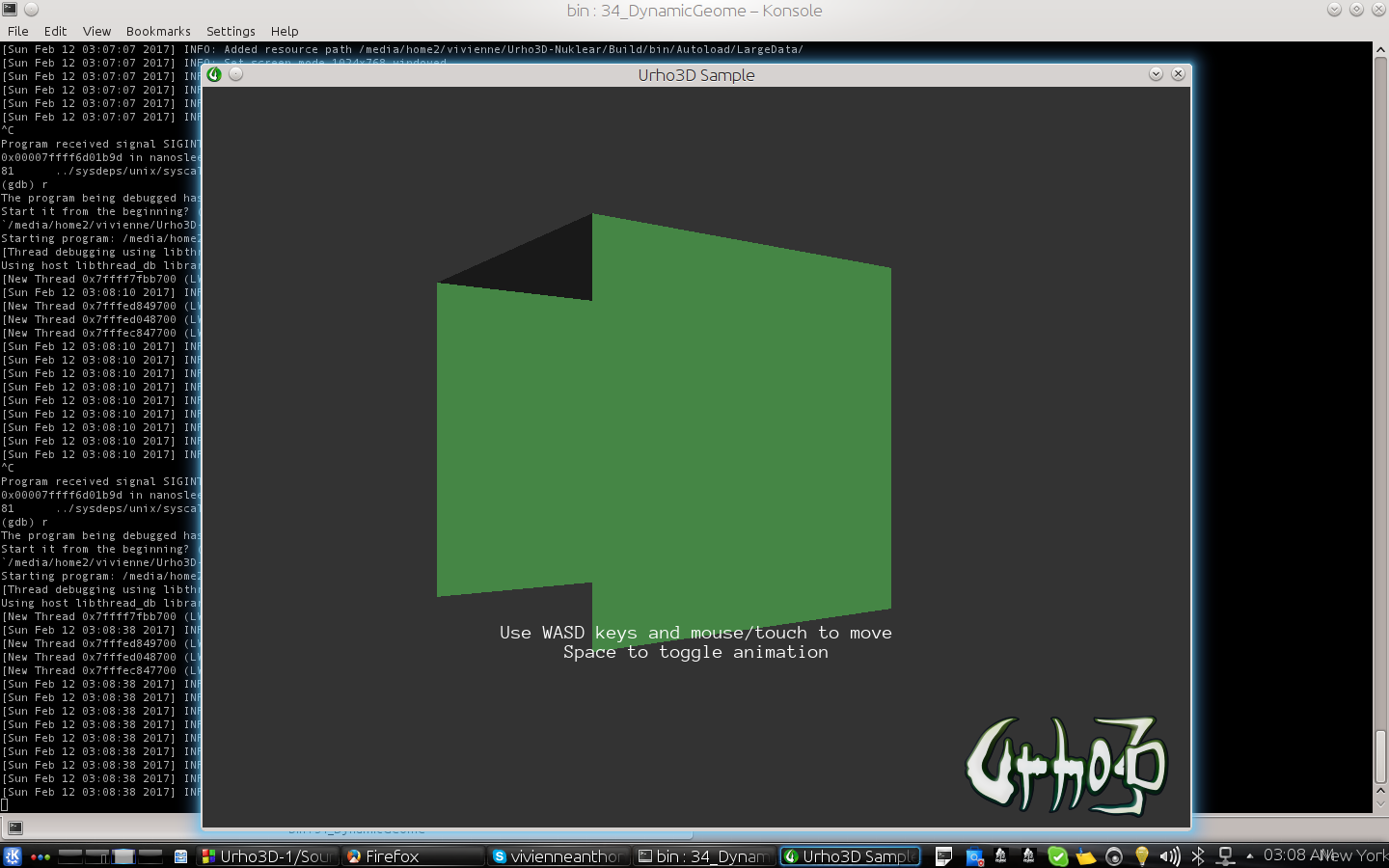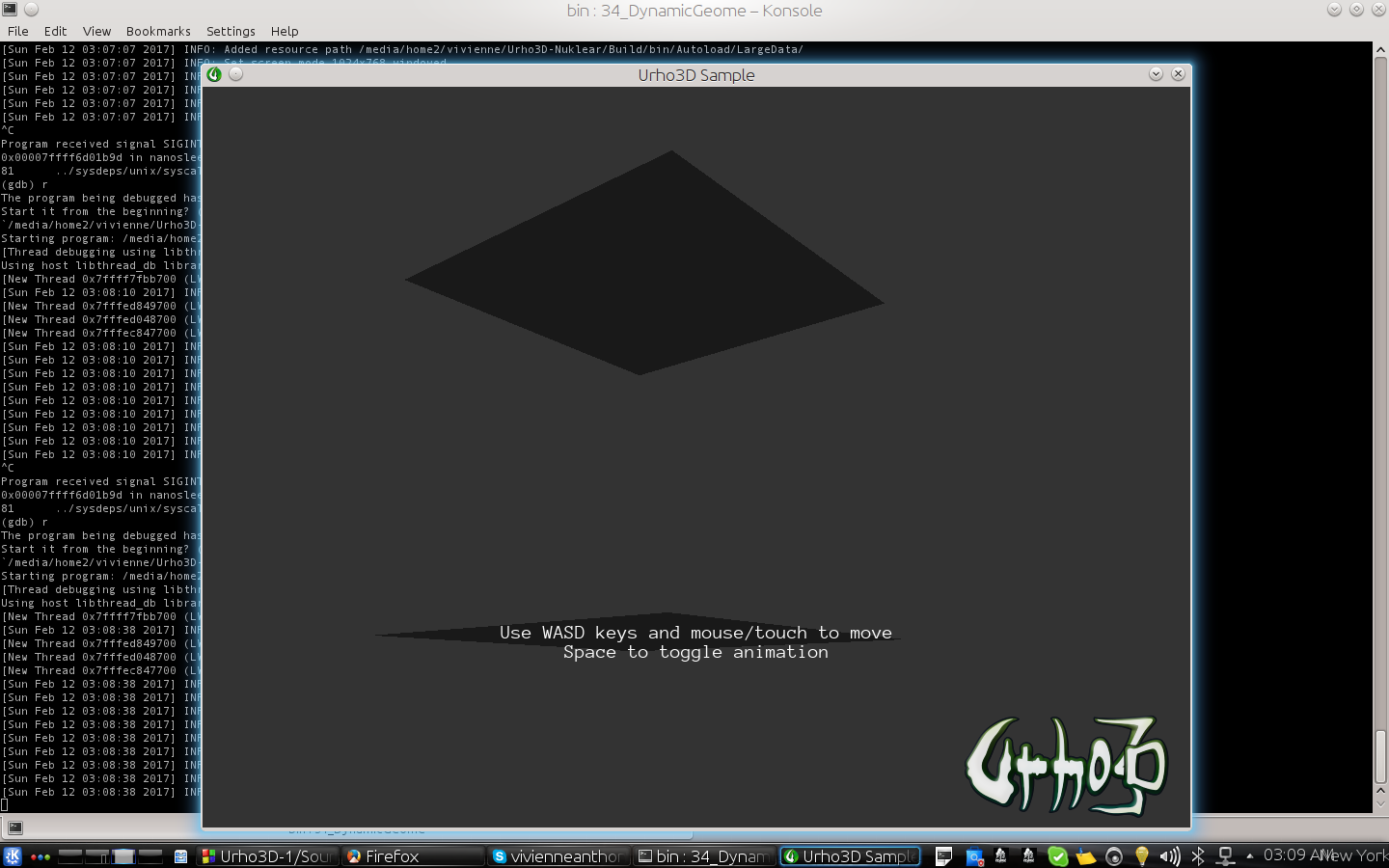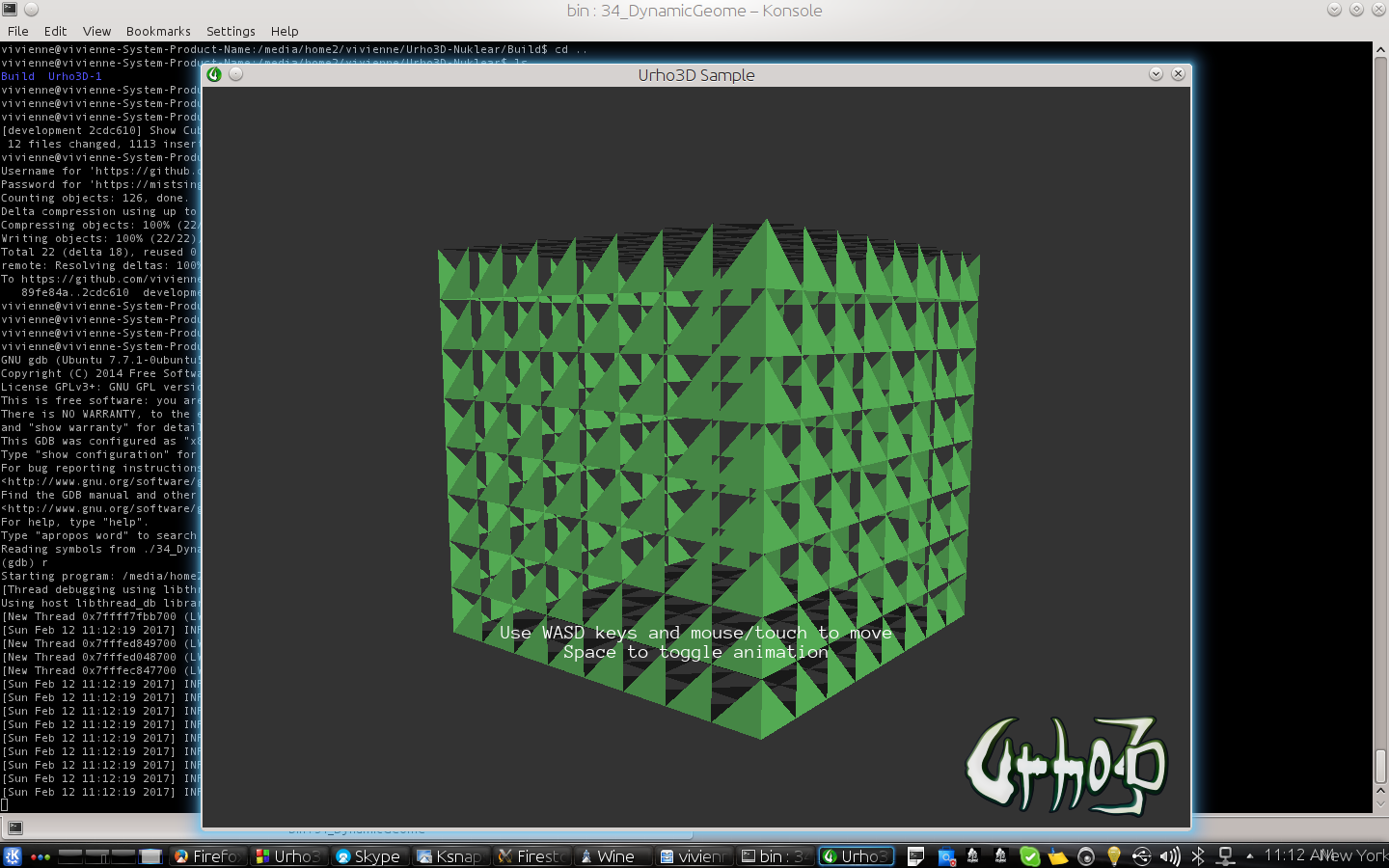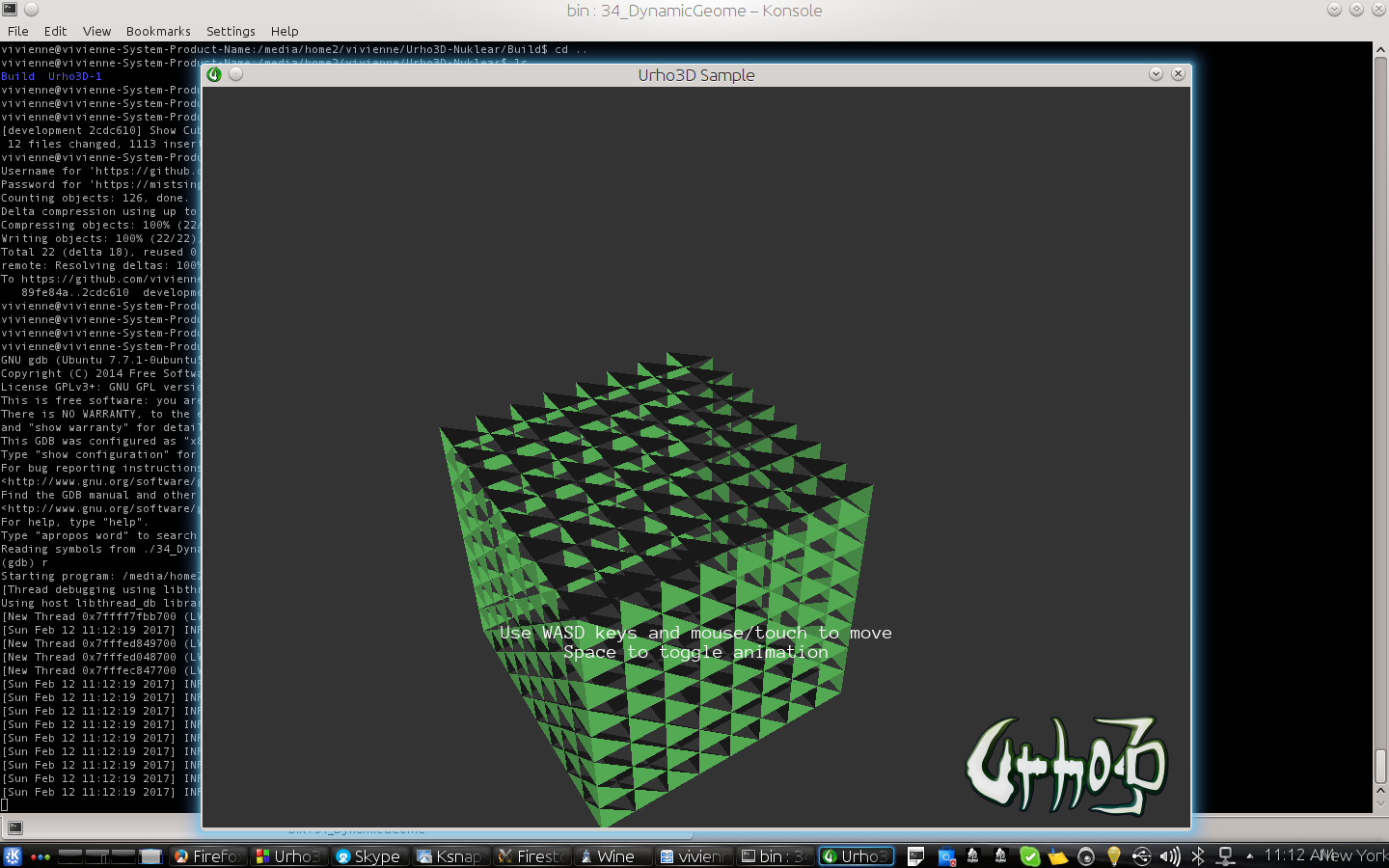Hey,
I have some code and it’s not showing 3 sides of a cube. I cannot figure what’s wrong. As I experminted with several ways. The code to produce the normal is right.
I’m going cut and paste the full code maybe someone can pick up on it.
void DynamicGeometry::CreateScene()
{
ResourceCache* cache = GetSubsystem<ResourceCache>();
scene_ = new Scene(context_);
// Create the Octree component to the scene so that drawable objects can be rendered. Use default volume
// (-1000, -1000, -1000) to (1000, 1000, 1000)
scene_->CreateComponent<Octree>();
// Create a Zone for ambient light & fog control
Node* zoneNode = scene_->CreateChild("Zone");
Zone* zone = zoneNode->CreateComponent<Zone>();
zone->SetBoundingBox(BoundingBox(-1000.0f, 1000.0f));
zone->SetFogColor(Color(0.2f, 0.2f, 0.2f));
zone->SetFogStart(200.0f);
zone->SetFogEnd(300.0f);
// Create a directional light
Node* lightNode = scene_->CreateChild("DirectionalLight");
lightNode->SetDirection(Vector3(-0.6f, -1.0f, -0.8f)); // The direction vector does not need to be normalized
Light* light = lightNode->CreateComponent<Light>();
light->SetLightType(LIGHT_DIRECTIONAL);
light->SetColor(Color(0.4f, 1.0f, 0.4f));
light->SetSpecularIntensity(1.5f);
// Get the original model and its unmodified vertices, which are used as source data for the animation
Model* originalModel = cache->GetResource<Model>("Models/Box.mdl");
if (!originalModel)
{
URHO3D_LOGERROR("Model not found, cannot initialize example scene");
return;
}
// Finally create one model (pyramid shape) and a StaticModel to display it from scratch
// Note: there are duplicated vertices to enable face normals. We will calculate normals programmatically
unsigned numVertices = 18;
// set chunks or patches
int PatchSize=8;
// Set Cube size
float CubeSize=10;;
// Get Cube Center - Create Defaults
Vector3 center = Vector3::ZERO;
Vector3 direction_x = Vector3::ZERO;
Vector3 direction_y = Vector3::ZERO;
// Create buffer
Vector<Vector3> vertexData;
Vector<unsigned short> indexData;
// Create a index
unsigned int index = 0;
for(unsigned int face=0; face< 6; face++)
{
// Get Cube Center
center = ((float)CubeSize/2)*TerrainFaceCoordinate[face];
// Calculate direction based of x
switch(face)
{
case Pos_X:
direction_x = CubeSize*Vector3(0,1,0);
direction_y = CubeSize*Vector3(0,0,1);
break;
case Neg_X:
direction_x = CubeSize*Vector3(0,1,0);
direction_y = CubeSize*Vector3(0,0,1);
break;
case Pos_Y:
direction_x = CubeSize*Vector3(1,0,0);
direction_y = CubeSize*Vector3(0,0,1);
break;
case Neg_Y:
direction_x = CubeSize*Vector3(1,0,0);
direction_y = CubeSize*Vector3(0,0,1);
break;
case Pos_Z:
direction_x = CubeSize*Vector3(1,0,0);
direction_y = CubeSize*Vector3(0,1,0);
break;
case Neg_Z:
direction_x = CubeSize*Vector3(1,0,0);
direction_y = CubeSize*Vector3(0,1,0);
break;
}
// loop through and create a grid of vertices. // do not draw edge
for (int u = 0; u < PatchSize; u++)
{
for (int v = 0; v < PatchSize; v++)
{
// Calculate patch size
Vector3 x1=(direction_x / PatchSize) * (v- PatchSize / 2);
Vector3 y1=(direction_y / PatchSize) * (u- PatchSize / 2);
// Create the vertex grid around the center of thecube face (which is passed into the function as Vector3 center).
Vector3 v1= center+ x1+y1;
// Calculate patch size
Vector3 x2=(direction_x / PatchSize) * ((v+1) - PatchSize / 2);
Vector3 y2=(direction_y / PatchSize) * (u- PatchSize / 2);
// Create the vertex grid around the center of thecube face (which is passed into the function as Vector3 center).
Vector3 v2= center+ x2+y2;
// Calculate patch size
Vector3 x3=(direction_x / PatchSize) * (v- PatchSize / 2);
Vector3 y3=(direction_y / PatchSize) * ((u+1)- PatchSize / 2);
// Create the vertex grid around the center of thecube face (which is passed into the function as Vector3 center).
Vector3 v3= center+ x3+y3;
// Calculate patch size
Vector3 x4=(direction_x / PatchSize) * ((v+1)- PatchSize / 2);
Vector3 y4=(direction_y / PatchSize) * ((u+1)- PatchSize / 2);
// Create the vertex grid around the center of thecube face (which is passed into the function as Vector3 center).
Vector3 v4=center+ x4+y4;
Vector3 n1;
Vector3 edge1 = v4-v1;
Vector3 edge2 = v3-v1;
n1= edge1.CrossProduct(edge2);
n1 = n1.Normalized();
// store first triangle
vertexData.Push(v1);
vertexData.Push(n1);
indexData.Push(index++);
vertexData.Push(v2);
vertexData.Push(n1);
indexData.Push(index++);
vertexData.Push(v4);
vertexData.Push(n1);
indexData.Push(index++);
// another trianlge
vertexData.Push(v4);
vertexData.Push(n1);
indexData.Push(index++);
vertexData.Push(v3);
vertexData.Push(n1);
indexData.Push(index++);
vertexData.Push(v1);
vertexData.Push(n1);
indexData.Push(index++);
}
}
}
numVertices = indexData.Size();
SharedPtr<Model> fromScratchModel(new Model(context_));
SharedPtr<VertexBuffer> vb(new VertexBuffer(context_));
SharedPtr<IndexBuffer> ib(new IndexBuffer(context_));
SharedPtr<Geometry> geom(new Geometry(context_));
// Shadowed buffer needed for raycasts to work, and so that data can be automatically restored on device loss
vb->SetShadowed(true);
// We could use the "legacy" element bitmask to define elements for more compact code, but let's demonstrate
// defining the vertex elements explicitly to allow any element types and order
PODVector<VertexElement> elements;
elements.Push(VertexElement(TYPE_VECTOR3, SEM_POSITION));
elements.Push(VertexElement(TYPE_VECTOR3, SEM_NORMAL));
vb->SetSize(numVertices, elements);
vb->SetData(&vertexData[0]);
ib->SetShadowed(true);
ib->SetSize(numVertices, false);
ib->SetData(&indexData[0]);
geom->SetVertexBuffer(0, vb);
geom->SetIndexBuffer(ib);
geom->SetDrawRange(TRIANGLE_LIST, 0, numVertices);
fromScratchModel->SetNumGeometries(1);
fromScratchModel->SetGeometry(0, 0, geom);
fromScratchModel->SetBoundingBox(BoundingBox(Vector3(-0.5f, -0.5f, -0.5f), Vector3(0.5f, 0.5f, 0.5f)));
// Though not necessary to render, the vertex & index buffers must be listed in the model so that it can be saved properly
Vector<SharedPtr<VertexBuffer> > vertexBuffers;
Vector<SharedPtr<IndexBuffer> > indexBuffers;
vertexBuffers.Push(vb);
indexBuffers.Push(ib);
// Morph ranges could also be not defined. Here we simply define a zero range (no morphing) for the vertex buffer
PODVector<unsigned> morphRangeStarts;
PODVector<unsigned> morphRangeCounts;
morphRangeStarts.Push(0);
morphRangeCounts.Push(0);
fromScratchModel->SetVertexBuffers(vertexBuffers, morphRangeStarts, morphRangeCounts);
fromScratchModel->SetIndexBuffers(indexBuffers);
Node* node = scene_->CreateChild("FromScratchObject");
node->SetPosition(Vector3(0.0f, 3.0f, 0.0f));
StaticModel* object = node->CreateComponent<StaticModel>();
object->SetModel(fromScratchModel);
// Create the camera
cameraNode_ = new Node(context_);
cameraNode_->SetPosition(Vector3(0.0f, 2.0f, -20.0f));
Camera* camera = cameraNode_->CreateComponent<Camera>();
camera->SetFarClip(300.0f);
}Vivienne






